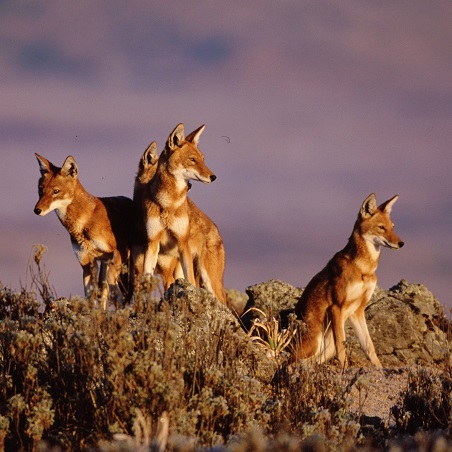
BY DARGIE KAHSAY
Ethiopia is home to various endemic wild animals. The Ethiopian wolf is among the endemic wild animal species in Ethiopia. The Ethiopian Wolf, a wolf endemic to Ethiopia, is the most researched wild animal in the country since it joined the red list, a list of critically endangered wild animals until 2011.
Now the population of this species is increasing, though still unsatisfactory, due to continuous researches and conservation efforts for the wolf and its habitat. This improvement is outcome of the continuous researches and conservation efforts by the Ethiopian Wolf Conservation Programme (EWCP) that invested in the field for almost three decades.
Girma Eshete (PhD) is a Conservation Biologist who currently is a Senior Researcher and Wolf Monitor at EWCP. He is also Lecturer of Wildlife Conservation at Bahir Dar University both for under graduate and post-graduate programmes. The Ethiopian Herald approached Dr. Girma to discuss the achievements of the EWCP in conserving the Ethiopian wolf and the Ethiopian wolfs current situations.
EWCP was established in 1995 under the umbrella of Oxford University Wildlife Conservation Research Unit jointly with the Ethiopian Wildlife Conservation Authority (EWCA). In Ethiopia, the programme is working with Ethiopian Wild Life Conservation Authority (EWCA), Amhara State Environment and Forest Conservation Programme and Oromia State Forest and Wildlife Enterprise.
The focus of the programme is researching and conserving the critically endangered Ethiopian Wolf, and its habitat, the afro-alpine ecosystem. The programme focuses on researching and conserving the biodiversity of the ecosystem by taking the Ethiopian Wolf as a flagship and iconic species.
The need to conserve Afro Alpine ecosystem
“The Afro-alpine ecosystem is an ecosystem found in the mountainous epics above 3,200 meters above sea level. The species, both plant and wildlife, found within this ecosystem are mostly endemic to Ethiopia” Girma stated. “Since the Ethiopian wolf habits within this ecosystem, EWCP takes the Ethiopian wolf as flagship species to conserve the habitat and the biodiversity within this ecosystem as it is the home of many endemic plant and wildlife species,” he added.
Among the endemic wild animals inhabiting in the afro-alpine ecosystem, according to Girma, are the Ethiopian wolf, Walia Ibex, Chilada baboon, Menelik’s Bushbuck, Mountain Nyala, birds, rodents and several types of plant species. Hence for Girma conserving the Ethiopian wolf requires conserving this afro-alpine ecosystem which in turn means conserving these entire endemic wild and plant species.
Over 88 percent of the Ethiopian population resides in the surroundings of the afro-alpine ecosystem. This ecosystem also accommodates 60 percent of domestic animals, according to Girma. In addition, the afro-alpine ecosystem is a major origin of water source for the main basins of Ethiopia. The major Ethiopian basins, the Blue Nile (Abay) basin, Tekeze Basin, Awash Basin and Wabishebele basins are originating from this ecosystem, which makes the ecosystem a very crucial protector of nature. More importantly, this ecosystem is an origin of goods and services extracted from natural resources.
This area is densely populated by communities that depend on agriculture and extraction of natural resources. As a result, the ecosystem faces continuous degradation. This ecosystem is an architect ecosystem and conserving this ecosystem is not only conserving the unique plant and wildlife species but helps the sustainability of the benefits extracting from this ecosystem. This indirectly means conserving the highland and lowland habitats that are dependent on the resources originating from this ecosystem, including the surface water.
Dr. Girma says Ethiopia accounts for 80 percent of Africa’s afro-alpine ecosystem. In Ethiopia, this ecosystem is found within eight zones of Amhara and Oromia regional states. This ecosystem makes Ethiopia the water tower of Africa.
After EWCP started its programme in 1995 in Bale to conserve the then critically endangered Ethiopian Wolf, the programme expands its existence throughout the afro-alpine ecosystem since 2000. The Programme, started after the Wildlife Conservation and Research Unit (WCRU) crew from the Oxford University led by Claudio Sillero visited the Bale Mountains in 1986 and realized the necessity of conserving this rare and threatened species with special programme to secure their persistence.
Since then, the programme is active in Ethiopia across the afro-alpine ecosystems and achieved a lot in researching and conserving the Ethiopian wolf and its habitat. The Ethiopian Wolf currently habits in around six afro-alpine sites, Bale Mountains National Park, Arsi, Simien Mountains National Park, Abune Yoseph- Abuhay Garya in North Wollo, Borena Saynt National Park and Menz Guasa Community protected site. Half of the Ethiopian wolves are found at Bale Mountains National Park, where a significant portion of the country’s afro-alpine ecosystem rests in. Even though these wolves once habited in Chocke and Guna community protected areas, they are now no more there.
Ecosystem degradation, disease transmission from domestic dogs, like rabies and canine distemper, conflict between human and wolves are the major challenges for the wolf species. Over the years EWCP has been working to halt these challenges. The rapid encroachment of people and domestic animals and the dense population of the ecosystem is causing high rate of degradation on it. This affects the habitat of the wolf and other endemic animals.
Hence, according to Girma, the EWCP invests in research based capacity building, restoration of degrading habitats, vaccination for both domestic dogs and the wolves as well as community environmental education for attitudinal change to conserve both the wolf and the ecosystem. In addition, it focuses on raising awareness and introducing alternative livelihood opportunities like bee farming to create smooth coexistence between the people and the habitat.
Following the three decades of research and conservation works now this species has been delisted from the category of critically endangered wild animals to that of the endangered ones.
“Currently, the Ethiopian wolves’ viable population ranges between 450 to 500 in all sites half of which habits in Bale Mountains National Park while the remaining is distributed in five sites” Girma stated.
Based on the researches on the species and its habitat, important conservation programmes are designed and introduced to conserve the wolf and the ecosystem which is home to different endemic wildlife. EWCP remains at the front in researching, leading and introducing practical programmes collaborating with Ethiopian conservationists mainly with EWCA.
EWCP has programme offices in every site that the wolves habit in addition to its head office at Bale Mountains National Park. In every site, EWCP has wolf monitor biologists with the focus of monitoring the wolves in the field. The experts spent over 20 days a month in fields to follow up and monitor the wolves.
Hence, wolf monitoring and follow-up, habitat conservation and rehabilitation, disease control, community environmental education, investment in supporting the livelihood of the community in the area and capacity building are among the regular activities of the programme. Due to the continuous activities and efforts done to conserve the species, the sites that the Ethiopian wolf is found are now well conserved and protected sites. The inputs to take actions in conserving the Ethiopian wolf and the afro-alpine habitat are the outcomes of the researches by EWCP and its stakeholders
The Ethiopian Herald 18 October 2022




